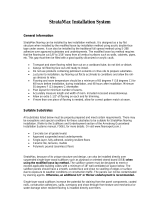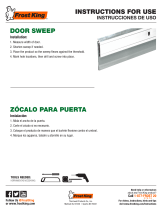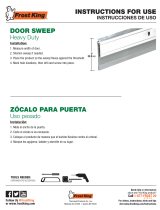Page is loading ...

LUXE PLANK
™
and the Lynx
™
Installation System
Patent pending.
THANK YOU FOR CHOOSING ARMSTRONG
®
FLOORING. Properly installed and cared for your new flooring will be easy to maintain and will keep its great look
for years. If you have questions or comments, please visit us at www.armstrong.com or call our Customer Relations and Technical Services at 1 800 233 3823.
Product Adhesive Comment
LUXE PLANK Lynx technology with overlapping pressure sensitive
adhesive.
Planks are bonded to each other, not to the
substrate.
WARNING: EXISTING IN-PLACE RESILIENT FLOOR COVERING AND ASPHALTIC ADHESIVES. DO NOT SAND, DRY SWEEP, DRY
SCRAPE, DRILL, SAW, BEADBLAST, OR MECHANICALLY CHIP OR PULVERIZE EXISTING RESILIENT FLOORING, BACKING, LINING
FELT, ASPHALTIC “CUTBACK” ADHESIVE, OR OTHER ADHESIVE.
These existing in-place products may contain asbestos fibers and/or crystalline silica. Avoid creating dust. Inhalation of such dust is a cancer and respiratory
tract hazard. Smoking by individuals exposed to asbestos fibers greatly increases the risk of serious bodily harm. Unless positively certain that the existing in-place
product is a non-asbestos-containing material, you must presume it contains asbestos. Regulations may require that the material be tested to determine asbestos
content and may govern removal and disposal of material.
See current edition of the Resilient Floor Covering Institute (RFCI) publication Recommended Work Practices for Removal of Resilient Floor Coverings for
instructions on removing all resilient floor covering structures or contact your retailer or Armstrong World Industries, Inc. 1 800 233 3823.
The floor covering or adhesive in this package does NOT contain asbestos.
General Information
The Lynx installation system allows the planks to be
bonded together by an overlapped edge method. The
planks are not bonded directly to the subfloor and
this will help hide some minor substrate irregularities
without telegraphing through to the face of the
planks. The planks should be installed 1/8˝ away from
all vertical surfaces such as walls, cabinets, pipes, etc.
(a larger gap could cause excessive floor movement).
When installed in bathrooms, the gap should be filled
and sealed with a good quality siliconized or acrylic
caulk. The gap will then be covered with molding or
wall base. Base cabinets should not be installed on
top of the planks.
Included in each carton are two LUXE PLANK
transition strips. These can be used to change
direction during the installation process or to
make repairs as discussed in the Repair Procedure
instructions.
Keys to Successful LUXE PLANK Installation
• Mostinstallationswillneedapproximately10%
cutting allowance added to the square footage
of the room.
• Properconditioningofboththejobsiteandthe
flooring is necessary. LUXE PLANK should not
be exposed to sudden changes in temperature
or moisture/humidity.
• Store,transportandhandleLUXE PLANK so
as to prevent any distortions. Store cartons flat,
never on edge. Distortions will not disappear
over time. Insure that the planks are laying flat
at time of installation.
• Donotcompresstheedgesoftheoating
installation in any way when installing other
flooring materials next to LUXE PLANK.
Installation of carpet, metal strips and other
transition moldings should not push fullness
into the flooring and should allow for some
slight movement wherever practical.
• Protecttheoorfromheavyrollingloads,other
trades and replacement and/or movement of
appliances by using sheets of plywood or similar.
Suitable Substrates
All substrates listed must be properly prepared
and meet certain requirements. There may be
other exceptions and special conditions for these
substrates to be suitable for the Lynx Installation
System as noted below. (Refer to the Subfloors and
Underlayments section of the Armstrong Guaranteed
Installation System manual, F-5061, for more details,
or visit www.floorexpert.com.)
• Concrete–dryandsmoothonallgradelevels
• Suspendedwoodsuboorswithapproved
woodunderlayments–musthaveminimumof
18˝ well-ventilated crawl space underneath
• Suspendedhardwoodooringthatisfully
adhered, smooth and square edge without
texture
• Single-layer,fullyadhered,existingresilient
oors–mustnotbefoam-backedorcushion-
backed
• Ceramictile,Terrazzo,Marble
• PolymericPoured(seamless)Floors
DO NOT INSTALL OVER
• Particleboardorwaferboard
• Single-layerwoodsuboors*
• Existingresilienttileoorsthatarebelowgrade
• Existingcushion-backedvinylooring
• Carpet
• Hardwoodooringthathasbeeninstalled
directly over concrete
• Onstairs,or,inroomswithslopingoorsor
floor drains
* Installation directly over single-layer wood subfloors
in new construction is not recommended. New
construction should have additional underlayment on
top of the subflooring and be installed as late in the
building schedule as possible; after permanent HVAC
is running, the home is properly conditioned, and other
trades have completed their work.
If it is unavoidable to install over single-layer wood
subfloors, it should only happen in remodel work
where the home has been occupied and conditioned
for a minimum of 1 year, having gone through the
initial winter season and dry-out of the new home. The
subflooring must meet all the substrate requirements
noted below.
Job Conditions/Preparations
• Allsubstratesmustbestructurallysound,dry,
clean, flat, and smooth with minimal deflection.
Substrates must be free from excessive
moisture or alkali. Remove dirt, paint, varnish,
wax, oils, solvents, other foreign matter and
contaminates that could cause staining or
interfere with the bond of the adhesive.
• Highspotsonthesubstrateshouldbe
leveled and low areas filled with appropriate
underlayments.
• Donotuseproductscontainingpetroleum,
solvents or citrus oils to prepare substrates as
they can cause staining and expansion of the
new flooring.
• Inrenovationorremodelwork,removeany
existingadhesiveresiduesothat100%ofthe
overall area of the original substrate is exposed.
• Wheninstallingoveranexistingresilientoor,
use S-199 One-Part Embossing Leveler or S-194
Patch, Underlayment & Embossing Leveler/S-195
Underlayment Additive to fill and smooth any
embossing in the old floor.
• Embossedceramictileoors,ceramicand
marblegroutjoints,andirregularitiesin
concrete should be filled and leveled using
S-194 Patch, Underlayment & Embossing
Leveler/S-195 Underlayment Additive or other
Armstrong cementitious underlayments.
• Theareatoreceiveresilientooring,ooring
materials and adhesives should be maintained
between 65° F (18° C) and 85° F (29° C) for
48 hours before installation, during installation,
and 48 hours after completion. Maintain
temperatures between 55° F (13° C) and 85° F
(29° C) thereafter.
• Resilientooringshouldonlybeinstalledin
temperature-controlled environments. It is
necessary to maintain a constant temperature.
Therefore, the permanent HVAC system
must be in operation before the installation
of resilient flooring. Portable heaters are not
recommended as they may not heat the room
and subfloor sufficiently. Kerosene heaters
should never be used.
• Forconcretesuboors,thewatervapor
emission level should be 5 lbs. /1000 sq.ft./24
hours, or less, as determined by calcium
chloride testing.
• Radiantheatedsubstratesmustnotexceeda
maximum surface temperature of 85° F (29° C).
• LUXE PLANK should not be exposed to direct
sunlight for prolonged periods. It can result
in discoloration and excessive temperatures
that may cause expansion. The use of drapes
or blinds is recommended during peak sunlight
exposure.
Procedure
Remove baseboard, quarter-round moldings, wall
base, appliances and furniture from room. For best
results, door trim should be under-cut to allow
flooring to move freely without being pinched. After
preparation work, sweep and vacuum the entire
work area to remove all dust and debris.
Note: Planks are easily cut with a tile cutter or
by using a straight edge and utility knife. Score
the face of the plank several times and snap it.
If it doesn’t separate, lightly cut through the
back on the fold mark.

Layout
Wheneverpossible,planthelayoutsothatthejoints
intheplanksdonotfallontopofjointsorseamsin
theexistingsubstrate.Theendjointsoftheplanks
should be staggered a minimum of 6˝ apart. Do not
installoverexpansionjoints.
Determine which direction the planks will run.
Find the center of each of the end walls (the walls
perpendicular to the long dimension of the planks)
and place a pencil mark on the floor. Connect these
points by striking a chalk line down the center of the
room. Do a dry layout of planks from the center line
to the wall running parallel to the long direction of
the planks to determine the width of the last row of
planks.
CENTER
OF ROOM
Fig. 1 – Dry layout to determine width of border plank.
Avoid having border pieces less than 2-1/4˝ (5.7cm)
wide for the 4-1/2˝ (11.4cm) wide planks and less
than 3˝ (7.6cm) wide for the 6˝ (15.2cm) wide planks.
If you find the border planks will be less than 1/2 the
width of the plank, the center starting line should be
shifted a distance equal to 1/2 the plank width. This
will “balance” the room and provide for a larger cut
piece at the wall.
Installation
Most installations will start along the longest, straight
wall in the room. The planks will be installed starting
in the corner of the room on the left side of the
starting wall (as you are facing it). The bottom
overlap film should be exposed on the side and end
of the plank facing away from the left corner of the
starting wall (Figure 2). Remove the paper release
liner exposing the adhesive on the bottom overlap
film.
Note: The pressure sensitive adhesive has a long
working time after the release paper has been
removed. It must, however, be protected from dust
and debris after the release paper is removed and
untilitiscoveredwithanotherplank.Ifthejobis
stopped prior to completion, leave the release paper
intact on the long edge only, of the last row of planks.
This will prevent dust or traffic from other trades
from interfering with the adhesive’s performance.
Starting Wall
Pared Inicial
Mur de départ
Bottom overlap of plank base
Sobrelapamiento de debajo de la base de la tablilla
Rebord inférieur de la base de la planche
Fig. 2 – Left corner of starting wall.
CAUTION – Do not stand or walk on release
paper liner, as it is extremely slippery. Place it in a
wastebasket immediately upon removal from the plank.
Begin laying the first row of planks. Place the top
overlap on the exposed bottom overlap film (with
adhesive) of the preceding plank. Press into place
to obtain adhesion. Use a hand roller if available, or,
rub the seam with moderate hand pressure using
a clean dry cloth. Neatly butt the plank face edges
together. Continue, left to right, with the first row of
planks until you near the end and need to cut the last
plank to fit. Try to avoid having planks shorter than
8˝ at the ends of rows. You may have to cut some
additional length off the starting plank and slide the
first row toward the left so the last plank will be at
least 8˝ in length. Remember to leave a gap of 1/8˝
from the end wall and cut the last piece in that row
to fit.
Start the second row on the left side with a piece
cut to about 2/3 the length of the starting plank in
therstrow.Itisimportanttokeeptheendjoints
staggeredaminimumof6˝inadjacentrows
(Figure 3). Both the long side edges and the short
ends of planks should be neatly butted against
adjoiningplanksandthoseinadjacentrows.Useone
hand to hold the plank, and the other hand to guide
the edges into place by lowering the plank as you go.
It’s important to butt the edges together neatly. Press
into place or use a hand roller to obtain adhesion.
Ifthejointsarenottight,pulluptheplankand
reposition it immediately.
Note: LUXE PLANK
™
is precisely made to size
and squareness. After the first 3 rows of planks are
installed they should be checked with a string line
to insure that rows are still running straight. If they
are not, it could be that the starting wall has some
irregularities that caused bowing in the installation. If
so, the starting row of planks may have to be scribed
and retrimmed to account for any unevenness in the
wall. This can be done without having to disassemble
the beginning rows.
Minimum 8” Length
Longitud Mínima de 8”
Longueur minimale de 20,32 cm (8 po)
Minimum 6” overlap at the joints
Mínimo de 6” de solapamiento en las uniones
Chevauchement minimal de 15,24 cm (6 po) aux joints
1/8” gap
De 1/8” de espacio
Espace de 13 mm (1/8 po)
Starting Wall
Pared Inicial
Mur de départ
Fig, 3 – Stagger end joints by 6˝, cut pieces at ends of
row should be 8˝ or greater.
Continue installing the remaining rows in similar
fashion.Maintainthe6˝minimumstaggeredendjoints
between rows and maintain the gap at perimeter
and vertical surfaces. After you have enough rows
in place, you may find it easier to turn around and
work on top of the newly installed planks for the
remainder of the room.
LUXE PLANK transition strips, included in each
carton, can be used when changing direction of the
installation to return into a closet or alcove area of
the room. LUXE PLANK transition strips are also
recommended in the repair procedures for damaged
planks (see below).
After the installation is completed, roll the entire
floor, in both directions with a 100-pound roller. Use
a hand roller in confined areas where the large roller
will not reach, such as under toe kicks.
Finishing the Installation
Replace molding or wall base, allowing slight
clearance between the molding and the planks. Nail
the molding to the wall surface, not through the
flooring. At doorways and at other areas where
LUXE PLANK may meet other flooring surfaces, it is
preferable to use a “T” molding or similar to cover
the exposed edge but not pinch the planks. Leave
asmallgapbetweentheplanksandtheadjoining
surface.
When replacing appliances, or whenever moving
heavy furniture over the flooring, place a wood panel
undertheobject.Withoutmovingthepanel,slideor
rolltheobjectoverit.Followwithadditionalpanels
as needed. This prevents scratches, tears or buckling
of the flooring material.
Care and Maintenance
IMPORTANT: Do not wash or scrub the new
LUXE PLANK flooring for at least 5 days after the
installation. This will allow the planks to become
“seated” in the adhesive and prevent excess moisture
and cleaning agents from interfering with the
adhesive bond.
Proactive Protection for Your Floor
• Whenmovingappliancesorheavyfurnitureit
is always wise to lay a plywood panel on your
floor and “walk” the item across it. This protects
your floor from scuffing and tears.
• Useoorprotectors,suchasArmstrong
Floor Protectors, under furniture to reduce
indentation. As a general rule of thumb, the
heavier the item, the wider the floor protector
needed.
• Placeawalk-offmatatoutsideentrancesto
reduce the amount of dirt brought into your
home. We strongly recommend mats without a
latex or rubber backing since these backings can
cause permanent discoloration.
• AllArmstrongoorcareproductshavebeen
specifically developed to care for Armstrong
floors.
Caring for Your Floor
• Sweeporvacuumregularly,toremoveloose
dirt which can scratch your floor.
Note: We do not recommend vacuums that
have a beater bar since it can visibly damage
your flooring surface. Additionally, we do not
recommend electric brooms with hard plastic
bottoms with no padding as use may result in
discoloration and deglossing.
• Wipeupspillsassoonaspossible.Neveruse
highly abrasive scrubbing tools on any resilient
floor.
• Washyouroorregularlywithavinyloor
cleaner such as Armstrong Once ’n Done
®
Resilient & Ceramic Floor Cleaner.
• DoNOTusedetergents,abrasivecleaners,or
“mop and shine” products. These products may
leave a dull film on your floor.
• Overtime,iftheshineonyouroorbeginsto
dull, apply Armstrong SatinKeeper
®
Resilient
Low Gloss Floor Finish to restore the
appearance of LUXE PLANK. Do NOT use
paste wax or solvent based polishes.
• Vinylooring,likeothertypesofsmoothoors,
can become slippery when wet. Allow time for
floor to dry after washing. Immediately wipe up
wet areas from spills, foreign substance, or wet
feet.
Repair Procedure
For damaged bottom overlap film on plank
prior to installation.
If the exposed film with adhesive is severely wrinkled
or damaged prior to installation the damaged
portion can be removed and replaced with a piece
of the LUXE PLANK transition strips supplied in
everycarton.Sometimes,justbendingitintheother
direction will allow the film to lay flat enough for
normal installation. If this doesn’t work:
1. Turn the plank over so the back is exposed
2. Use a utility knife to score through the back
film with a straight cut 2 inches from and
parallel to the edge of the damaged film
3. Make additional cuts to isolate the damaged
portion of film from the undamaged areas
4. Carefully peel the damaged area from the back
of the plank, leaving the undamaged areas intact
5. Cut a piece of the LUXE PLANK transition
strip to the proper length to replace the
damaged film
6. Strip release paper from the LUXE PLANK
transition strip and adhere it to the back of
the plank in the void where the damage was
removed (do not overlap the LUXE PLANK
/


